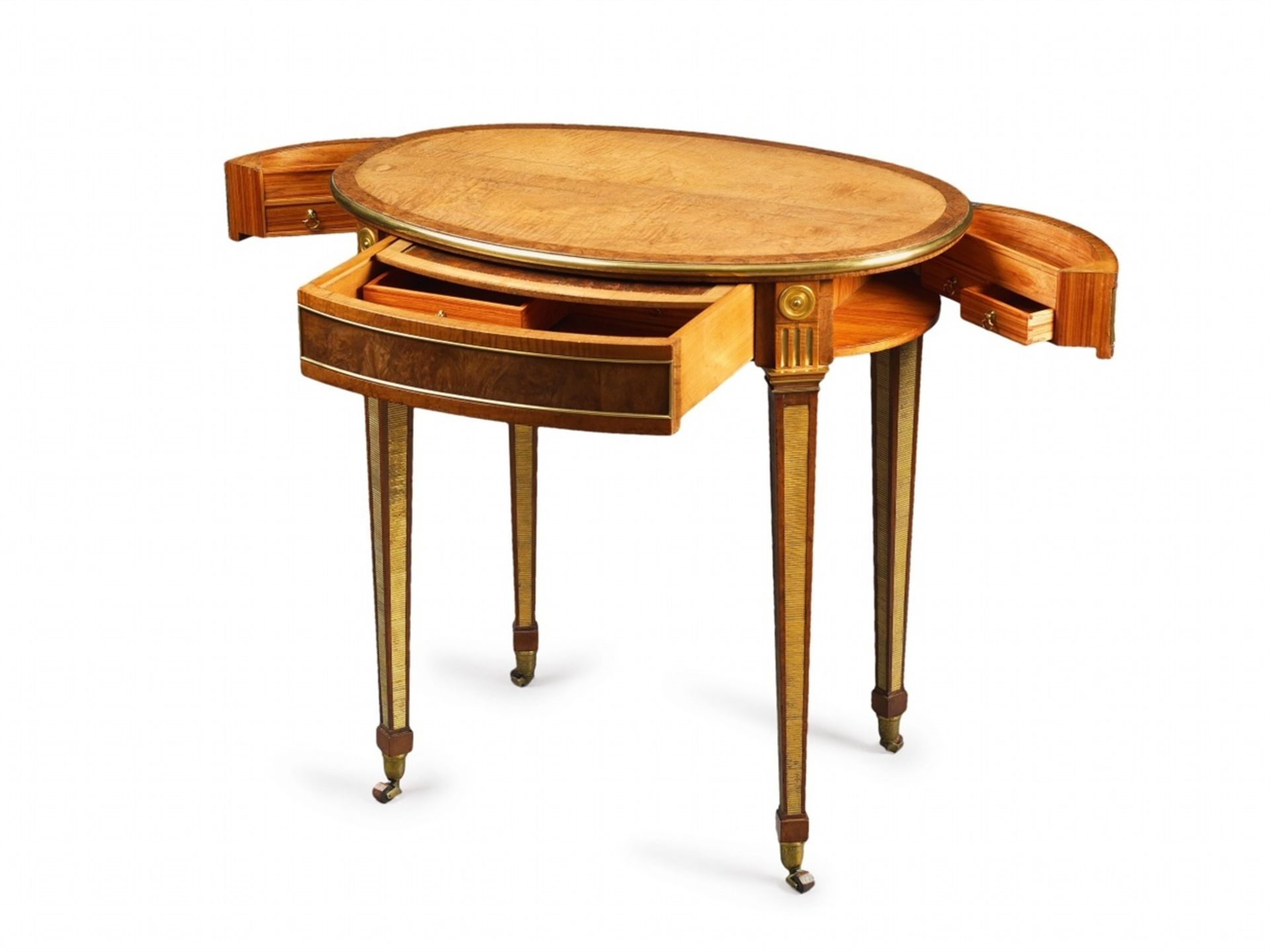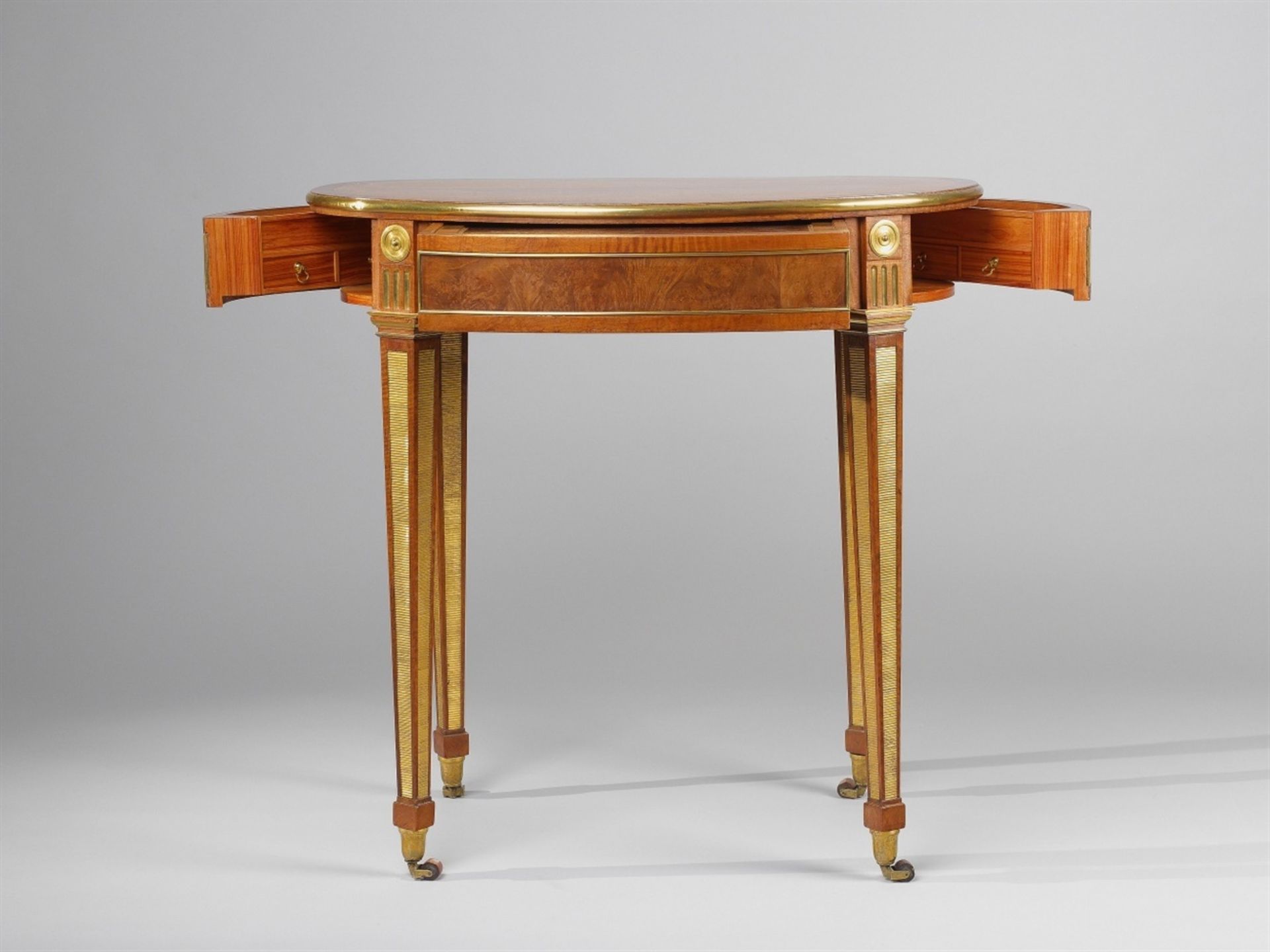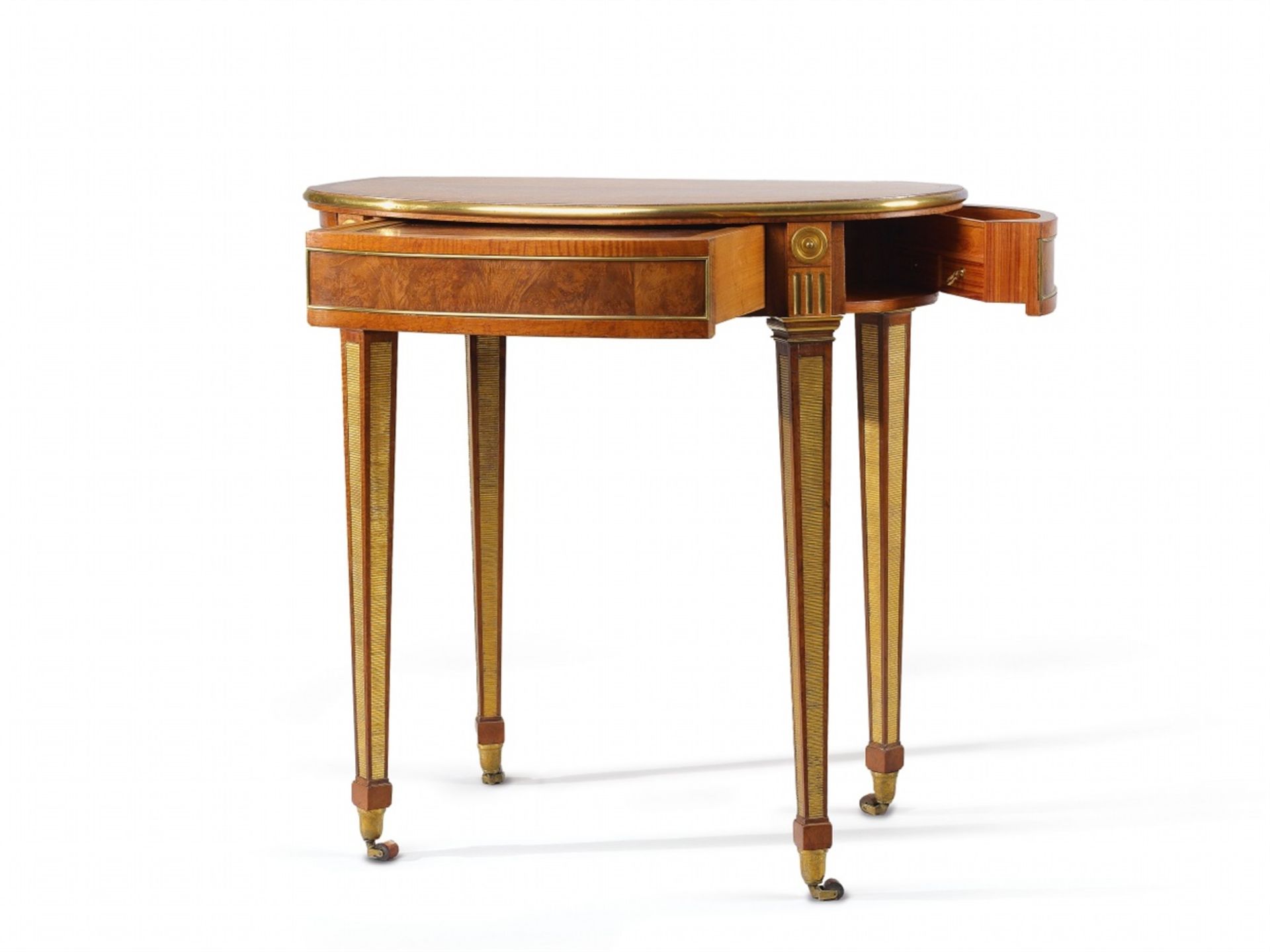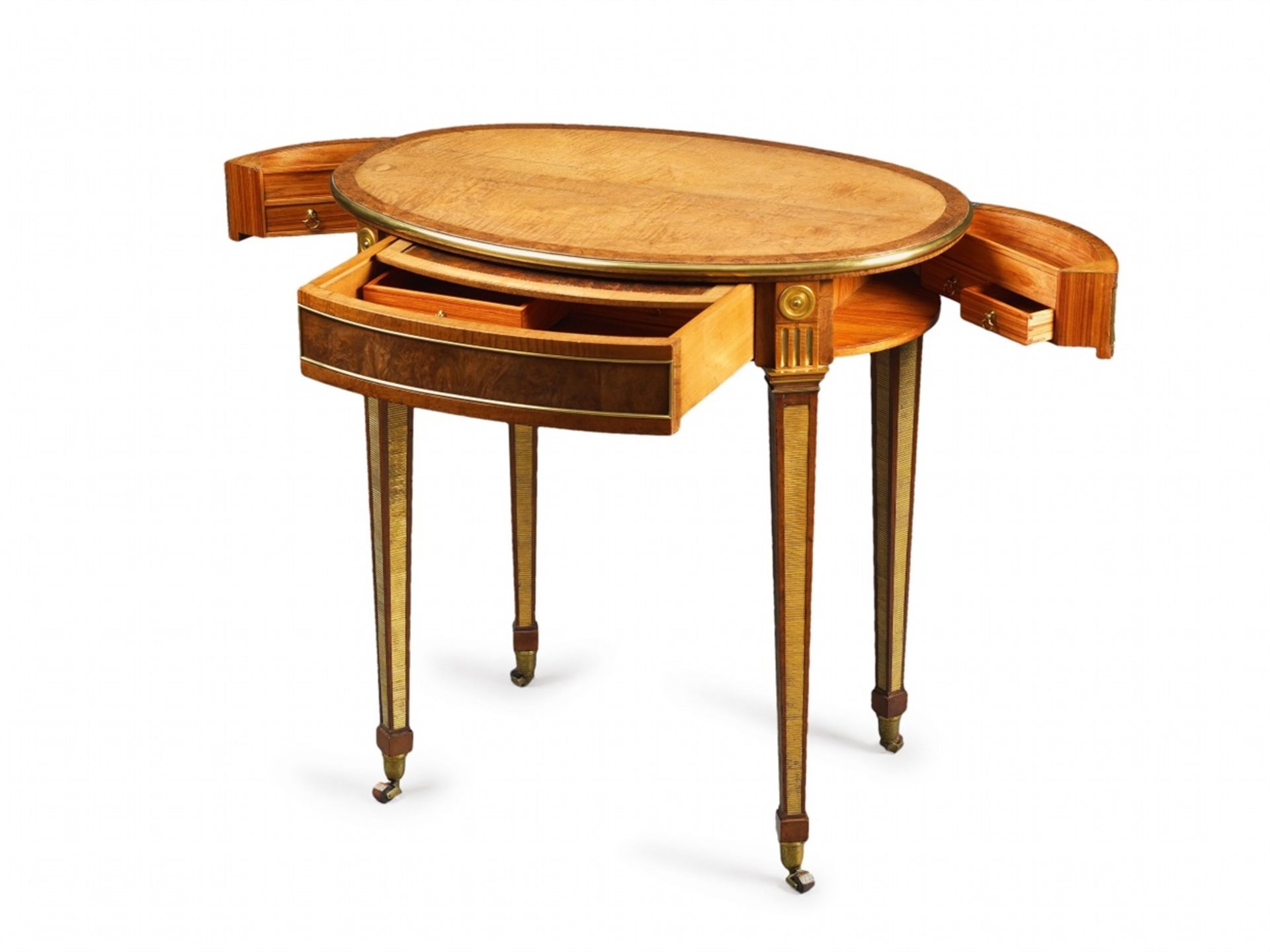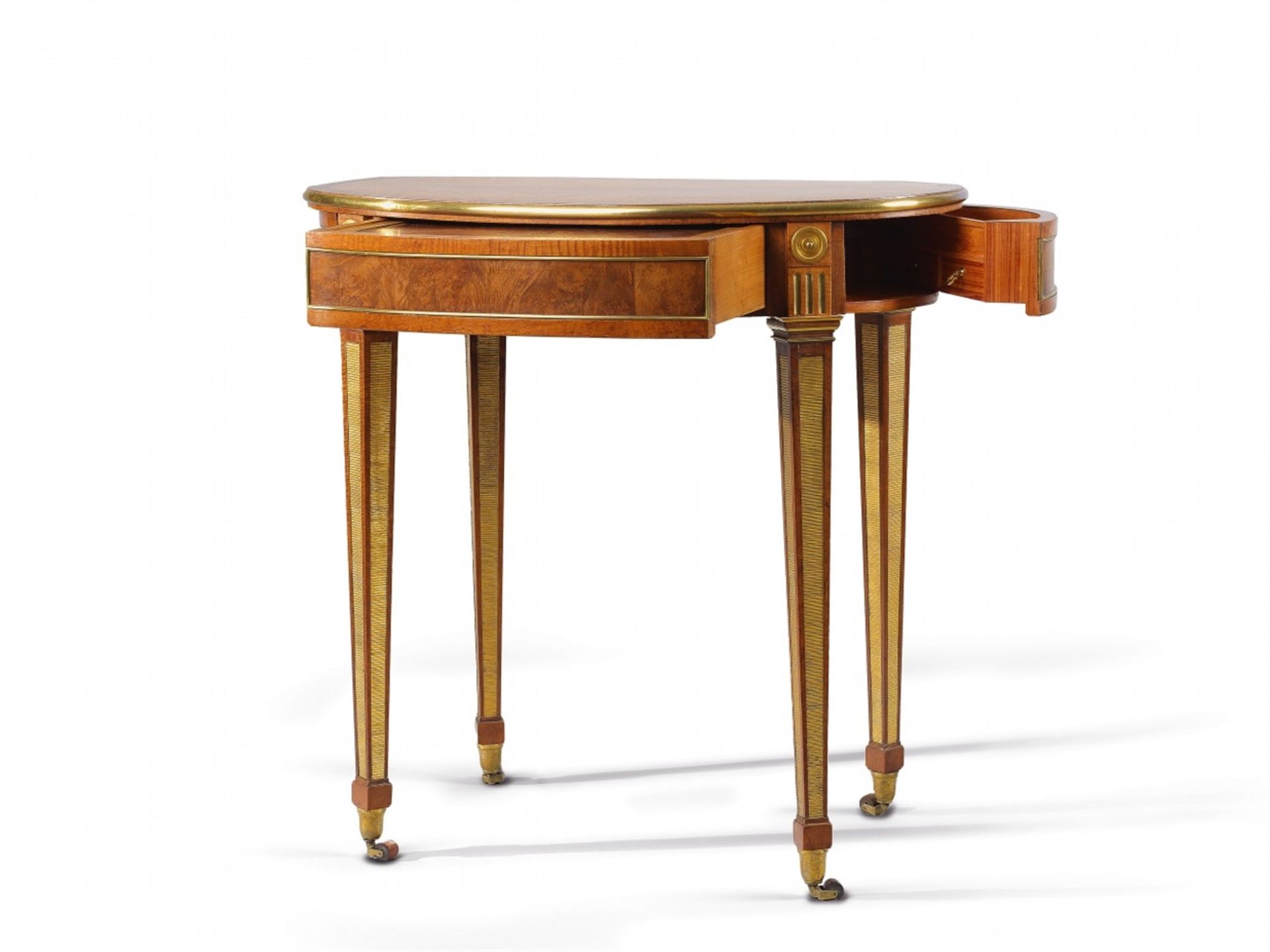401
Ovaler Arbeitstisch von David Roentgen
Ovaler Arbeitstisch von David Roentgen
Riegel- und Vogelaugenahorn auf Nuss, Satinholz, Rosenholz und Mahagoni massiv, braunes Leder ersetzt, Messingprofile, feuervergoldete Bronze. Multifunktionstisch mit vier abschraubbaren verjüngten Vierkantbeinen auf Rollen. In der Front ein durch Druck öffnender, breiter Schub mit Schreibplatte, darunter zwei Innenschübe und ein Federmechanismus zum Öffnen der seitlichen Segmentfächer. Diese ausgestattet mit einem Fach über zwei Schüben. Altverfüllte Risse in der Platte, Federmechanismus reparaturbedürftig. H 72,5, B 73, T 51 cm.
Neuwied, 1780 - 1790.
Der Typus des kleinen ovalen Tisches taucht bei David Roentgen ab ca. 1770 auf. Eines der ersten bekannten Exemplare ist ein als Kriegsverlust gekennzeichneter Tisch, für Friedrich II. gefertigt, ehemals im Neuen Palais, Potsdam, mit einer grazilen Gestaltung, konkav eingezogener Zarge und s-förmigen Beinen, die durch einen Kreuzsteg miteinander verbunden sind.
Das hier vorgestellte Möbel existiert in verschiedenen Ausführungen, je nach Auftrag mehr oder weniger aufwändig produziert. Die Zargen und die Deckplatten sind meist mit reichen Intarsien, Blumen oder den bekannten Chinoiserien verziert, noch ohne Bronzen- oder Messingauflagen.
Ab 1775 findet sukzessive ein Geschmackswandel statt. Zunächst werden die Formen gerade, die Zargen höher. Beispiele dafür finden sich heute im Rijksmuseum Amsterdam, im Victoria & Albert Museum London oder in der Sammlung The Metropolitan Museum New York. In der Folgezeit verschwinden die Intarsien und Marketerien vollständig. Die Betonung liegt auf der Maserung und der Farbe des Holzes. Gegliedert werden die Möbel nun durch Profile aus vergoldeter Bronze oder Messing, die Länge der Beine wird durch aufgelegte vergoldete milleraies betont. Genau in diese Phase lässt sich der hier angebotene Tisch datieren.
Provenienz
Privatsammlung Bretagne, Frankreich.
Daxer & Marschall, München.
Privatsammlung Nordrhein-Westfalen.
Literatur
Abgebildet in: Präzision und Hingabe, Möbelkunst Roentgen, Berlin 2007, S. 170.
Vgl. Greber, Abraham und David Roentgen, Möbel für Europa, Band 1, Starnberg 1980, S. 139ff und S. 230ff.
Vgl. Greber, Abraham und David Roentgen, Möbel für Europa, Band 2, Starnberg 1980, Abb. 613ff.
Vgl. Fabian, Roentgen Möbel aus Neuwied, Bad Neustadt 1986, Abb. 80ff.
Vgl. Fabian, Abraham und David Roentgen. Das noch aufgefundene Gesamtwerk ihrer Möbel- und Uhrenkunst in Verbindung mit der Uhrmacherfamilie Kinzing in Neuwied. Leben und Werk, Verzeichnis der Werke, Quellen, Bad Neustadt 1996, Nr. 84.
Vgl. Koeppe u.a., Extravagant Inventions: The Princely Furniture of the Roentgens, New York 2012, Kat. Nr. 20-22 und 48.
Dieses Objekt wurde unter Verwendung von Materialien hergestellt, für die beim Export in Ländern außerhalb der EU eine Genehmigung nach CITES erforderlich ist. Wir machen darauf aufmerksam, dass eine Genehmigung im Regelfall nicht erteilt wird.
An oval work table by David Roentgen
Banded and bird's eye maple on solid walnut, satinwood, rosewood, and mahogany corpus. Brown leather writing surface (replaced), ormolu mountings. Multi-functional table with four removable square-sectioned supports terminating in casters. The front with a wide push-to-open drawer containing a writing surface concealing two interior drawers and a spring mechanism to open the two side segments. The side segments each fitted with a compartment and two drawers. Old, filled shrinkage cracks to the tabletop, the spring mechanism in need of repair. H 72.5, W 73, D 51 cm.
Neuwied, 1780 - 1790.
This type of small oval table appears in David Roentgen's oeuvre in around 1770. One of the first known examples was a table made for Friedrich II which was formerly housed in the Neues Palais in Potsdam but is since listed as being lost in the war. The piece was of an elegant design with a waisted apron and s-shaped supports connected by a cruciform stretcher.
We know of several versions of the present design, which were produced in a greater or lesser degree of opulence according to the commission. Their aprons and tops tend to be decorated with rich inlaid designs of flowers or well-known chinoiserie motifs. None of the pieces yet featured appliqués of bronze or brass, but a gradual change in taste could be observed beginning in the year 1775. Forms became straighter, and aprons higher. Examples of such works can be found in the Rijksmuseum in Amsterdam, the Victoria & Albert Museum in London, and in the collection of the Metropolitan Museum in New York. Following these years, marquetries and inlays began to disappear, and more focus was placed upon the grain and pattern of the wood itself. Furniture designs were divided using gilt bronze or brass mouldings, and the length of the legs was accentuated by gilded milleraies fillings. The present work can be dated to exactly this phase.
Provenance
Private collection, Bretagne, France.
Daxer & Marschall, Munich.
Private collection, North Rhine-Westphalia.
Literature
Illustrated in Präzision und Hingabe, Möbelkunst Roentgen, Berlin 2007, p. 170.
Cf. Greber, Abraham und David Roentgen, Möbel für Europa, vol. 1, Starnberg 1980, p. 139ff and p. 230ff.
Cf. Greber, Abraham und David Roentgen, Möbel für Europa, vol. 2, Starnberg 1980, illus. 613ff.
Cf. Fabian, Roentgen Möbel aus Neuwied, Bad Neustadt 1986, illus. 80ff.
Cf. Fabian, Abraham und David Roentgen. Das noch aufgefundene Gesamtwerk ihrer Möbel- und Uhrenkunst in Verbindung mit der Uhrmacherfamilie Kinzing in Neuwied. Leben und Werk, Verzeichnis der Werke, Quellen, Bad Neustadt 1996, no. 84.
Cf. Koeppe, Extravagant Inventions, New York 2013, cat. no. 20-22 and 48.
This lot contains materials which require a CITES licence for export outside of the EU contract countries. We would like to inform you that such licenses are usually not granted.
Ovaler Arbeitstisch von David Roentgen
Riegel- und Vogelaugenahorn auf Nuss, Satinholz, Rosenholz und Mahagoni massiv, braunes Leder ersetzt, Messingprofile, feuervergoldete Bronze. Multifunktionstisch mit vier abschraubbaren verjüngten Vierkantbeinen auf Rollen. In der Front ein durch Druck öffnender, breiter Schub mit Schreibplatte, darunter zwei Innenschübe und ein Federmechanismus zum Öffnen der seitlichen Segmentfächer. Diese ausgestattet mit einem Fach über zwei Schüben. Altverfüllte Risse in der Platte, Federmechanismus reparaturbedürftig. H 72,5, B 73, T 51 cm.
Neuwied, 1780 - 1790.
Der Typus des kleinen ovalen Tisches taucht bei David Roentgen ab ca. 1770 auf. Eines der ersten bekannten Exemplare ist ein als Kriegsverlust gekennzeichneter Tisch, für Friedrich II. gefertigt, ehemals im Neuen Palais, Potsdam, mit einer grazilen Gestaltung, konkav eingezogener Zarge und s-förmigen Beinen, die durch einen Kreuzsteg miteinander verbunden sind.
Das hier vorgestellte Möbel existiert in verschiedenen Ausführungen, je nach Auftrag mehr oder weniger aufwändig produziert. Die Zargen und die Deckplatten sind meist mit reichen Intarsien, Blumen oder den bekannten Chinoiserien verziert, noch ohne Bronzen- oder Messingauflagen.
Ab 1775 findet sukzessive ein Geschmackswandel statt. Zunächst werden die Formen gerade, die Zargen höher. Beispiele dafür finden sich heute im Rijksmuseum Amsterdam, im Victoria & Albert Museum London oder in der Sammlung The Metropolitan Museum New York. In der Folgezeit verschwinden die Intarsien und Marketerien vollständig. Die Betonung liegt auf der Maserung und der Farbe des Holzes. Gegliedert werden die Möbel nun durch Profile aus vergoldeter Bronze oder Messing, die Länge der Beine wird durch aufgelegte vergoldete milleraies betont. Genau in diese Phase lässt sich der hier angebotene Tisch datieren.
Provenienz
Privatsammlung Bretagne, Frankreich.
Daxer & Marschall, München.
Privatsammlung Nordrhein-Westfalen.
Literatur
Abgebildet in: Präzision und Hingabe, Möbelkunst Roentgen, Berlin 2007, S. 170.
Vgl. Greber, Abraham und David Roentgen, Möbel für Europa, Band 1, Starnberg 1980, S. 139ff und S. 230ff.
Vgl. Greber, Abraham und David Roentgen, Möbel für Europa, Band 2, Starnberg 1980, Abb. 613ff.
Vgl. Fabian, Roentgen Möbel aus Neuwied, Bad Neustadt 1986, Abb. 80ff.
Vgl. Fabian, Abraham und David Roentgen. Das noch aufgefundene Gesamtwerk ihrer Möbel- und Uhrenkunst in Verbindung mit der Uhrmacherfamilie Kinzing in Neuwied. Leben und Werk, Verzeichnis der Werke, Quellen, Bad Neustadt 1996, Nr. 84.
Vgl. Koeppe u.a., Extravagant Inventions: The Princely Furniture of the Roentgens, New York 2012, Kat. Nr. 20-22 und 48.
Dieses Objekt wurde unter Verwendung von Materialien hergestellt, für die beim Export in Ländern außerhalb der EU eine Genehmigung nach CITES erforderlich ist. Wir machen darauf aufmerksam, dass eine Genehmigung im Regelfall nicht erteilt wird.
An oval work table by David Roentgen
Banded and bird's eye maple on solid walnut, satinwood, rosewood, and mahogany corpus. Brown leather writing surface (replaced), ormolu mountings. Multi-functional table with four removable square-sectioned supports terminating in casters. The front with a wide push-to-open drawer containing a writing surface concealing two interior drawers and a spring mechanism to open the two side segments. The side segments each fitted with a compartment and two drawers. Old, filled shrinkage cracks to the tabletop, the spring mechanism in need of repair. H 72.5, W 73, D 51 cm.
Neuwied, 1780 - 1790.
This type of small oval table appears in David Roentgen's oeuvre in around 1770. One of the first known examples was a table made for Friedrich II which was formerly housed in the Neues Palais in Potsdam but is since listed as being lost in the war. The piece was of an elegant design with a waisted apron and s-shaped supports connected by a cruciform stretcher.
We know of several versions of the present design, which were produced in a greater or lesser degree of opulence according to the commission. Their aprons and tops tend to be decorated with rich inlaid designs of flowers or well-known chinoiserie motifs. None of the pieces yet featured appliqués of bronze or brass, but a gradual change in taste could be observed beginning in the year 1775. Forms became straighter, and aprons higher. Examples of such works can be found in the Rijksmuseum in Amsterdam, the Victoria & Albert Museum in London, and in the collection of the Metropolitan Museum in New York. Following these years, marquetries and inlays began to disappear, and more focus was placed upon the grain and pattern of the wood itself. Furniture designs were divided using gilt bronze or brass mouldings, and the length of the legs was accentuated by gilded milleraies fillings. The present work can be dated to exactly this phase.
Provenance
Private collection, Bretagne, France.
Daxer & Marschall, Munich.
Private collection, North Rhine-Westphalia.
Literature
Illustrated in Präzision und Hingabe, Möbelkunst Roentgen, Berlin 2007, p. 170.
Cf. Greber, Abraham und David Roentgen, Möbel für Europa, vol. 1, Starnberg 1980, p. 139ff and p. 230ff.
Cf. Greber, Abraham und David Roentgen, Möbel für Europa, vol. 2, Starnberg 1980, illus. 613ff.
Cf. Fabian, Roentgen Möbel aus Neuwied, Bad Neustadt 1986, illus. 80ff.
Cf. Fabian, Abraham und David Roentgen. Das noch aufgefundene Gesamtwerk ihrer Möbel- und Uhrenkunst in Verbindung mit der Uhrmacherfamilie Kinzing in Neuwied. Leben und Werk, Verzeichnis der Werke, Quellen, Bad Neustadt 1996, no. 84.
Cf. Koeppe, Extravagant Inventions, New York 2013, cat. no. 20-22 and 48.
This lot contains materials which require a CITES licence for export outside of the EU contract countries. We would like to inform you that such licenses are usually not granted.
Modernes Kunstgewerbe / Sammlung Dreßen / Kunstgewerbe / Abraham & David Roentgen
Auktionsdatum
Ort der Versteigerung
Für Kunsthaus Lempertz Versandinformtation bitte wählen Sie +49 (0)221 9257290.
Wichtige Informationen
Zu Aufgeld und Mehrwertsteuer prüfen Sie bitte das jeweilige Los.
For buyer’s premium and VAT please check particular lot.
AGB
standard | standard
Conditions of Sale
1. The art auction house, Kunsthaus Lempertz KG (henceforth referred to as Lempertz), conducts public auctions in terms of § 383 paragraph 3 sentence 1 of the Civil Code as commissioning agent on behalf of the accounts of submitters, who remain anonymous. With regard to its auctioneering terms and conditions drawn up in other languages, the German version remains the official one.
2. The auctioneer reserves the right to divide or combine any catalogue lots or, if it has special reason to do so, to offer any lot for sale in an order different from that given in the catalogue or to withdraw any lot from the sale.
3. All lots put up for sale may be viewed and inspected prior to the auction. The catalogue specifications and related specifications appearing on the internet, which have both been compiled in good conscience, do not form part of the contractually agreed to conditions. These specifications have been derived from the status of the information available at the time of compiling the catalogue. They do not serve as a guarantee in legal terms and their purpose is purely in the information they provide. The same applies to any reports on an item’s condition or any other information, either in oral or written form. Certificates or certifications from artists, their estates or experts relevant to each case only form a contractual part of the agreement if they are specifically mentioned in the catalogue text. The state of the item is generally not mentioned in the catalogue. Likewise missing specifications do not constitute an agreement on quality. All items are used goods.
4. Warranty claims are excluded. In the event of variances from the catalogue descriptions, which result in negation or substantial diminution of value or suitability, and which are reported with due justification within one year after handover, Lempertz nevertheless undertakes to pursue its rights against the seller through the courts; in the event of a successful claim against the seller, Lempertz will reimburse the buyer only the total purchase price paid. Over and above this, Lempertz undertakes to reimburse its commission within a given period of three years after the date of the sale if the object in question proves not to be authentic.
5. Claims for compensation as the result of a fault or defect in the object auctioned or damage to it or its loss, regardless of the legal grounds, or as the result of variances from the catalogue description or statements made elsewhere are excluded unless Lempertz acted with wilful intent or gross negligence; the liability for bodily injury or damages caused to health or life remains unaffected. In other regards, point 4 applies.
6. Submission of bids. Bids in attendance: The floor bidder receives a bidding number on presentation of a photo ID. Lempertz reserves the right to grant entry to the auction. If the bidder is not known to Lempertz, registration must take place 24 hours before the auction is due to begin in writing on presentation of a current bank reference. Bids in absentia: Bids can also be submitted either in writing, telephonically or via the internet. The placing of bids in absentia must reach Lempertz 24 hours before the auction to ensure the proper processing thereof. The item must be mentioned in the bid placed, together with the lot number and item description. In the event of ambiguities, the listed lot number becomes applicable. The placement of a bid must be signed by the applicant. The regulations regarding revocations and the right to return the goods in the case of long distance agreements (§ 312b-d of the Civil Code) do not apply. Telephone bids: Establishing and maintaining a connection cannot be vouched for. In submitting a bid placement, the bidder declares that he agrees to the recording of the bidding process. Bids via the internet: They will only be accepted by Lempertz if the bidder registered himself on the internet website beforehand. Lempertz will treat such bids in the same way as bids in writing.
7. Carrying out the auction: The hammer will come down when no higher bids are submitted after three calls for a bid. In extenuating circumstances, the auctioneer reserves the right to bring down the hammer or he can refuse to accept a bid. If several individuals make the same bid at the same time, and after the third call, no higher bid ensues, then the ticket becomes the deciding factor. The auctioneer can retract his acceptance of the bid and auction the item once more if a higher bid that was submitted on time, was erroneously overlooked and immediately queried by the bidder, or if any doubts regarding its acceptance arise. Written bids are only played to an absolute maximum by Lempertz if this is deemed necessary to outbid
another bid. The auctioneer can bid on behalf of the submitter up to the agreed limit, without revealing this and irrespective of whether other bids are submitted. Even if bids have been placed and the hammer has not come down, the auctioneer is only liable to the bidder in the event of premeditation or gross negligence.
8. Once a lot has been knocked down, the successful bidder is obliged to buy it. If a bid is accepted conditionally, the bidder is bound by his bid until four weeks after the auction unless he immediately withdraws from the conditionally accepted bid. From the fall of the hammer, possession and risk pass directly to the buyer, while ownership passes to the buyer only after full payment has been received.
9. Up to a hammer price of € 400,000 a premium of 24 % calculated on the hammer price plus 19 % value added tax (VAT) calculated on the premium only is levied. The premium will be reduced to 20 % (plus VAT) on any amount surpassing € 400,000 (margin scheme). On lots which are characterized by N, an additional 7 % for import tax will be charged. On lots which are characterized by an D, 35% is calculated on the hammer price (24% buyer´s premium + 19% VAT on the premium only + import tax). 31% is calculated on the amount surpassing € 400.000. The D objects contain all taxes, and tehy can not be carried away immediately. On lots which are characterized by an R, the buyer shall pay a premium of 24 % on the hammer price up to € 400,000 and 20 % on the surpassing amount; onto this (hammer price and premium) the statutory VAT of 19 % will be added (regular scheme). Exports to third (i.e. non-EU) countries will be exempt from VAT, and so will be exports made by companies from other EU member states if they state their VAT identification number. For original works of art, whose authors are either still alive or died after 31.12.1948, a charge of 1.8 % on the hammer price will be levied for the droit de suite. The maximum charge is € 12,500. If a buyer exports an object to a third country personally, the VAT will be refunded, as soon as Lempertz receives the export and import papers. All invoices issued on the day of auction or soon after remain under provision.
10. Successful bidders attending the auction in person shall forthwith upon the purchase pay to Lempertz the final price (hammer price plus premium and VAT) in Euro. Payments by foreign buyers who have bid in writing or by proxy shall also be due forthwith upon the purchase, but will not be deemed to have been delayed if received within ten days of the invoice date. Bank transfers are to be exclusively in Euros. The request for an alteration of an auction invoice to a person other than the bidder has to be made immediately after the auction. Lempertz however reserves the right to refuse such a request if it is deemed appropriate.
11. In the case of payment default, Lempertz will charge 1% interest on the outstanding amount of the gross price per month.. If the buyer defaults in payment, Lempertz may at its discretion insist on performance of the purchase contract or, after allowing a period of grace, claim damages for non-performance. In the latter case, Lempertz may determine the amount of the damages by putting the lot or lots up for auction again, in which case the defaulting buyer will bear the amount of any reduction in the proceeds compared with the earlier auction, plus the cost of resale, including the premium.
12. Buyers must take charge of their purchases immediately after the auction. Once a lot has been sold, the auctioneer is liable only for wilful intent or gross negligence. Lots will not, however, be surrendered to buyers until full payment has been received. Without exception, shipment will be at the expense and risk of the buyer. Purchases which are not collected within four weeks after the auction may be stored and insured by Lempertz on behalf of the buyer and at its expense in the premises of a freight agent. If Lempertz stores such items itself, it will charge 1 % of the hammer price for insurance and storage costs.
13. As far as this can be agreed, the place of performance and jurisdiction is Cologne. German law applies; the German law for the protection of cultural goods applies; the provisions of the United Nations Convention on Contracts for the International Sale of Goods (CISG) are not applicable. Should any provision herein be wholly or partially ineffective, this will not affect the validity of the remaining provisions.
Henrik Hanstein, sworn public auctioneer
Takuro Ito, Kilian Jay von Seldeneck, auctioneers












